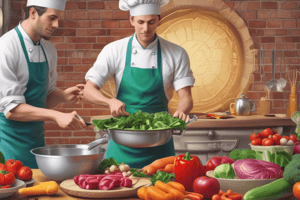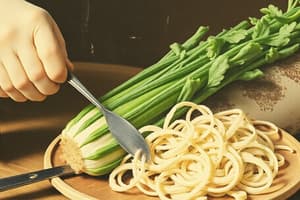Podcast
Questions and Answers
What is the primary reason for properly washing vegetables?
What is the primary reason for properly washing vegetables?
- To reduce cooking time
- To improve texture
- To enhance flavor
- To prevent foodborne illnesses (correct)
Extended soaking of vegetables is generally recommended in professional kitchens.
Extended soaking of vegetables is generally recommended in professional kitchens.
False (B)
What is the purpose of briefly soaking certain produce in cold salted water?
What is the purpose of briefly soaking certain produce in cold salted water?
kills insects
To restore crispness to limp vegetables, briefly soak them in ____________________ water.
To restore crispness to limp vegetables, briefly soak them in ____________________ water.
What is the benefit of using a drain insert in storage containers?
What is the benefit of using a drain insert in storage containers?
A very tight cover on storage containers is recommended for leafy greens.
A very tight cover on storage containers is recommended for leafy greens.
Match the following vegetable preparation steps with their purposes:
Match the following vegetable preparation steps with their purposes:
Why is it important to peel and cut vegetables shortly before cooking?
Why is it important to peel and cut vegetables shortly before cooking?
What can be done to prevent browning in easily oxidizable vegetables?
What can be done to prevent browning in easily oxidizable vegetables?
Tomatoes are vegetables.
Tomatoes are vegetables.
What is a fruit in botanical terms?
What is a fruit in botanical terms?
Edible trimmings can be recycled into ______________, boosting resource efficiency in culinary techniques.
Edible trimmings can be recycled into ______________, boosting resource efficiency in culinary techniques.
Why is organizing vegetables based on their biological origin not always useful?
Why is organizing vegetables based on their biological origin not always useful?
Okra and eggplant are both roots.
Okra and eggplant are both roots.
Roots and tubers have fairly firm, ______________ textures and are handled similarly.
Roots and tubers have fairly firm, ______________ textures and are handled similarly.
Match the following vegetables with their classification:
Match the following vegetables with their classification:
What might indicate damage to the can's protective lining?
What might indicate damage to the can's protective lining?
Canned vegetables require proper boiling.
Canned vegetables require proper boiling.
What is the recommended temperature for serving canned vegetables?
What is the recommended temperature for serving canned vegetables?
Dried beans and peas have been used as food for __________ years.
Dried beans and peas have been used as food for __________ years.
Match the following types of dried vegetables with their description:
Match the following types of dried vegetables with their description:
Why is it important to wipe the can's top before opening?
Why is it important to wipe the can's top before opening?
All canned foods have a drained weight.
All canned foods have a drained weight.
What can be done to enhance the flavor of canned vegetables?
What can be done to enhance the flavor of canned vegetables?
What is the ideal storage condition for dried vegetables?
What is the ideal storage condition for dried vegetables?
It is recommended to mix batches when storing leftovers.
It is recommended to mix batches when storing leftovers.
How long can leftover creamed vegetables be stored?
How long can leftover creamed vegetables be stored?
Cans with signs of damage or spoilage, such as swelling, dents, or rust, should be ____________________.
Cans with signs of damage or spoilage, such as swelling, dents, or rust, should be ____________________.
Match the following storage conditions with the correct type of vegetable:
Match the following storage conditions with the correct type of vegetable:
Why is rapid cooling important when storing leftovers?
Why is rapid cooling important when storing leftovers?
What is the ideal storage temperature for potatoes, onions, and winter squash?
What is the ideal storage temperature for potatoes, onions, and winter squash?
It is recommended to store vegetables for as long as possible.
It is recommended to store vegetables for as long as possible.
Why is it important to keep peeled and cut vegetables covered or wrapped?
Why is it important to keep peeled and cut vegetables covered or wrapped?
To prevent browning, potatoes, eggplants, and other vegetables that brown when cut should be treated with an ____________________ or antioxidant.
To prevent browning, potatoes, eggplants, and other vegetables that brown when cut should be treated with an ____________________ or antioxidant.
What is crucial for quality and efficiency in a commercial kitchen?
What is crucial for quality and efficiency in a commercial kitchen?
Frozen vegetables do not require specific temperature and packaging requirements.
Frozen vegetables do not require specific temperature and packaging requirements.
Match the following storage requirements with the corresponding vegetables:
Match the following storage requirements with the corresponding vegetables:
Why is it important to keep refrigerators and storage areas clean?
Why is it important to keep refrigerators and storage areas clean?
Flashcards are hidden until you start studying
Study Notes
Vegetable Preparation
- Proper preparation of ingredients reduces cooking time, streamlines operations, and upholds sanitary standards, preventing foodborne illnesses and ensuring efficiency and safety in the culinary process.
- In professional kitchens, thorough vegetable preparation is required, including washing, peeling, and cutting.
- Washing involves rinsing vegetables in cold water to remove dirt and debris, with special care taken for root vegetables like potatoes, which require intense scrubbing.
- Leafy greens require multiple cold water rinses to remove dirt, and suitable drainage is critical to prevent rotting.
Soaking
- Extended soaking of vegetables is generally prohibited due to flavour and nutritional loss, with a few exceptions like cabbage, broccoli, and cauliflower, which benefit from a brief 30-minute soak in cold salted water.
- Brief soaking of limp vegetables in cold water can help restore crispness, while soaking dried legumes is necessary to replenish moisture lost during the drying process.
Peeling and Cutting
- When preparing fruits and vegetables, aim for a thin peel to keep nutrients beneath the surface, and ensure uniform cutting for even cooking.
- Peel and cut vegetables shortly before cooking to avoid drying and vitamin loss from oxidation.
- Prevent browning in easily oxidizable vegetables like potatoes and eggplant by employing acid or antioxidant solutions, or soak them in water until ready to use.
Classifying Vegetables
- From a botanical perspective, many fruits are mistakenly referred to as vegetables, such as tomatoes, which are technically fruits.
- A fruit is the ripening ovary or ovaries of a seed-bearing plant, which contains the seeds.
- Vegetables can be classified into categories like roots, tubers, and fruits, but this classification is not always useful in a culinary context.
Cooking
- Using precise techniques for preparing canned vegetables gives optimal outcomes, including wiping the can's top before opening and using a clean can opener to maintain hygiene.
- When draining vegetables, save half of the liquid for boiling to shorten subsequent cooking times.
- Canned vegetables require warming rather than boiling, and following health regulations, keep the temperature at 88°C for at least 10 minutes to reduce the risk of botulism.
Handling Dried Vegetables
- There are two basic kinds of dried vegetables, and proper storage procedures help to optimize kitchen operations, reduce waste, and maintain culinary standards.
Fresh Vegetables
- Correctly storing fresh vegetables in a commercial kitchen is vital for quality and efficiency, with each vegetable having unique specifications for temperature and humidity requirements.
- Potatoes, onions, and winter squash are stored at cool temperatures (50-65°F/10-18°C) in a dry, dark place.
- Other vegetables must be refrigerated, and peeled and cut vegetables need extra protection from drying and oxidation.
Frozen Vegetables
- In a commercial kitchen, proper storage of frozen vegetables is crucial for quality and efficiency, with adherence to specific temperature and packaging requirements for each vegetable.
- Store frozen vegetables at 0°F (-18°C) or colder, in original containers, until ready for use.
Dried Vegetables
- In a commercial kitchen, precise storage of dried vegetables is critical for longevity and culinary quality, with adherence to specific guidelines, such as maintaining airtight containers and ideal temperature conditions.
- Store dried vegetables in a cool (less than 75°F/24°C), dry, well-ventilated place, and keep them well sealed and off the floor.
Canned Vegetables
- Store canned vegetables in a cool, dry place, away from sunlight and off the floor, and discard cans that show signs of damage or spoilage.
Leftovers
- The best way to store leftovers is not to create them in the first place, and careful planning and small-batch cooking reduce leftovers.
- Store leftover creamed vegetables for one day only, and then either use or discard.
Studying That Suits You
Use AI to generate personalized quizzes and flashcards to suit your learning preferences.




